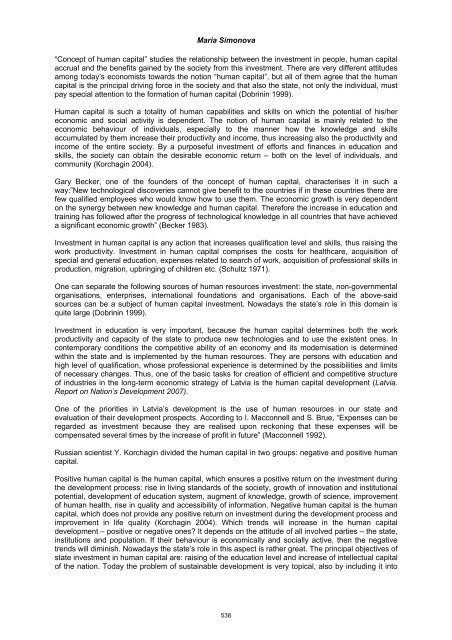Proceedings of the 3rd European Conference on Intellectual Capital
Proceedings of the 3rd European Conference on Intellectual Capital
Proceedings of the 3rd European Conference on Intellectual Capital
You also want an ePaper? Increase the reach of your titles
YUMPU automatically turns print PDFs into web optimized ePapers that Google loves.
Maria Sim<strong>on</strong>ova<br />
“C<strong>on</strong>cept <str<strong>on</strong>g>of</str<strong>on</strong>g> human capital” studies <str<strong>on</strong>g>the</str<strong>on</strong>g> relati<strong>on</strong>ship between <str<strong>on</strong>g>the</str<strong>on</strong>g> investment in people, human capital<br />
accrual and <str<strong>on</strong>g>the</str<strong>on</strong>g> benefits gained by <str<strong>on</strong>g>the</str<strong>on</strong>g> society from this investment. There are very different attitudes<br />
am<strong>on</strong>g today’s ec<strong>on</strong>omists towards <str<strong>on</strong>g>the</str<strong>on</strong>g> noti<strong>on</strong> “human capital”, but all <str<strong>on</strong>g>of</str<strong>on</strong>g> <str<strong>on</strong>g>the</str<strong>on</strong>g>m agree that <str<strong>on</strong>g>the</str<strong>on</strong>g> human<br />
capital is <str<strong>on</strong>g>the</str<strong>on</strong>g> principal driving force in <str<strong>on</strong>g>the</str<strong>on</strong>g> society and that also <str<strong>on</strong>g>the</str<strong>on</strong>g> state, not <strong>on</strong>ly <str<strong>on</strong>g>the</str<strong>on</strong>g> individual, must<br />
pay special attenti<strong>on</strong> to <str<strong>on</strong>g>the</str<strong>on</strong>g> formati<strong>on</strong> <str<strong>on</strong>g>of</str<strong>on</strong>g> human capital (Dobrinin 1999).<br />
Human capital is such a totality <str<strong>on</strong>g>of</str<strong>on</strong>g> human capabilities and skills <strong>on</strong> which <str<strong>on</strong>g>the</str<strong>on</strong>g> potential <str<strong>on</strong>g>of</str<strong>on</strong>g> his/her<br />
ec<strong>on</strong>omic and social activity is dependent. The noti<strong>on</strong> <str<strong>on</strong>g>of</str<strong>on</strong>g> human capital is mainly related to <str<strong>on</strong>g>the</str<strong>on</strong>g><br />
ec<strong>on</strong>omic behaviour <str<strong>on</strong>g>of</str<strong>on</strong>g> individuals, especially to <str<strong>on</strong>g>the</str<strong>on</strong>g> manner how <str<strong>on</strong>g>the</str<strong>on</strong>g> knowledge and skills<br />
accumulated by <str<strong>on</strong>g>the</str<strong>on</strong>g>m increase <str<strong>on</strong>g>the</str<strong>on</strong>g>ir productivity and income, thus increasing also <str<strong>on</strong>g>the</str<strong>on</strong>g> productivity and<br />
income <str<strong>on</strong>g>of</str<strong>on</strong>g> <str<strong>on</strong>g>the</str<strong>on</strong>g> entire society. By a purposeful investment <str<strong>on</strong>g>of</str<strong>on</strong>g> efforts and finances in educati<strong>on</strong> and<br />
skills, <str<strong>on</strong>g>the</str<strong>on</strong>g> society can obtain <str<strong>on</strong>g>the</str<strong>on</strong>g> desirable ec<strong>on</strong>omic return – both <strong>on</strong> <str<strong>on</strong>g>the</str<strong>on</strong>g> level <str<strong>on</strong>g>of</str<strong>on</strong>g> individuals, and<br />
community (Коrchagin 2004).<br />
Gary Becker, <strong>on</strong>e <str<strong>on</strong>g>of</str<strong>on</strong>g> <str<strong>on</strong>g>the</str<strong>on</strong>g> founders <str<strong>on</strong>g>of</str<strong>on</strong>g> <str<strong>on</strong>g>the</str<strong>on</strong>g> c<strong>on</strong>cept <str<strong>on</strong>g>of</str<strong>on</strong>g> human capital, characterises it in such a<br />
way:”New technological discoveries cannot give benefit to <str<strong>on</strong>g>the</str<strong>on</strong>g> countries if in <str<strong>on</strong>g>the</str<strong>on</strong>g>se countries <str<strong>on</strong>g>the</str<strong>on</strong>g>re are<br />
few qualified employees who would know how to use <str<strong>on</strong>g>the</str<strong>on</strong>g>m. The ec<strong>on</strong>omic growth is very dependent<br />
<strong>on</strong> <str<strong>on</strong>g>the</str<strong>on</strong>g> synergy between new knowledge and human capital. Therefore <str<strong>on</strong>g>the</str<strong>on</strong>g> increase in educati<strong>on</strong> and<br />
training has followed after <str<strong>on</strong>g>the</str<strong>on</strong>g> progress <str<strong>on</strong>g>of</str<strong>on</strong>g> technological knowledge in all countries that have achieved<br />
a significant ec<strong>on</strong>omic growth” (Becker 1983).<br />
Investment in human capital is any acti<strong>on</strong> that increases qualificati<strong>on</strong> level and skills, thus raising <str<strong>on</strong>g>the</str<strong>on</strong>g><br />
work productivity. Investment in human capital comprises <str<strong>on</strong>g>the</str<strong>on</strong>g> costs for healthcare, acquisiti<strong>on</strong> <str<strong>on</strong>g>of</str<strong>on</strong>g><br />
special and general educati<strong>on</strong>, expenses related to search <str<strong>on</strong>g>of</str<strong>on</strong>g> work, acquisiti<strong>on</strong> <str<strong>on</strong>g>of</str<strong>on</strong>g> pr<str<strong>on</strong>g>of</str<strong>on</strong>g>essi<strong>on</strong>al skills in<br />
producti<strong>on</strong>, migrati<strong>on</strong>, upbringing <str<strong>on</strong>g>of</str<strong>on</strong>g> children etc. (Schultz 1971).<br />
One can separate <str<strong>on</strong>g>the</str<strong>on</strong>g> following sources <str<strong>on</strong>g>of</str<strong>on</strong>g> human resources investment: <str<strong>on</strong>g>the</str<strong>on</strong>g> state, n<strong>on</strong>-governmental<br />
organisati<strong>on</strong>s, enterprises, internati<strong>on</strong>al foundati<strong>on</strong>s and organisati<strong>on</strong>s. Each <str<strong>on</strong>g>of</str<strong>on</strong>g> <str<strong>on</strong>g>the</str<strong>on</strong>g> above-said<br />
sources can be a subject <str<strong>on</strong>g>of</str<strong>on</strong>g> human capital investment. Nowadays <str<strong>on</strong>g>the</str<strong>on</strong>g> state’s role in this domain is<br />
quite large (Dobrinin 1999).<br />
Investment in educati<strong>on</strong> is very important, because <str<strong>on</strong>g>the</str<strong>on</strong>g> human capital determines both <str<strong>on</strong>g>the</str<strong>on</strong>g> work<br />
productivity and capacity <str<strong>on</strong>g>of</str<strong>on</strong>g> <str<strong>on</strong>g>the</str<strong>on</strong>g> state to produce new technologies and to use <str<strong>on</strong>g>the</str<strong>on</strong>g> existent <strong>on</strong>es. In<br />
c<strong>on</strong>temporary c<strong>on</strong>diti<strong>on</strong>s <str<strong>on</strong>g>the</str<strong>on</strong>g> competitive ability <str<strong>on</strong>g>of</str<strong>on</strong>g> an ec<strong>on</strong>omy and its modernisati<strong>on</strong> is determined<br />
within <str<strong>on</strong>g>the</str<strong>on</strong>g> state and is implemented by <str<strong>on</strong>g>the</str<strong>on</strong>g> human resources. They are pers<strong>on</strong>s with educati<strong>on</strong> and<br />
high level <str<strong>on</strong>g>of</str<strong>on</strong>g> qualificati<strong>on</strong>, whose pr<str<strong>on</strong>g>of</str<strong>on</strong>g>essi<strong>on</strong>al experience is determined by <str<strong>on</strong>g>the</str<strong>on</strong>g> possibilities and limits<br />
<str<strong>on</strong>g>of</str<strong>on</strong>g> necessary changes. Thus, <strong>on</strong>e <str<strong>on</strong>g>of</str<strong>on</strong>g> <str<strong>on</strong>g>the</str<strong>on</strong>g> basic tasks for creati<strong>on</strong> <str<strong>on</strong>g>of</str<strong>on</strong>g> efficient and competitive structure<br />
<str<strong>on</strong>g>of</str<strong>on</strong>g> industries in <str<strong>on</strong>g>the</str<strong>on</strong>g> l<strong>on</strong>g-term ec<strong>on</strong>omic strategy <str<strong>on</strong>g>of</str<strong>on</strong>g> Latvia is <str<strong>on</strong>g>the</str<strong>on</strong>g> human capital development (Latvia.<br />
Report <strong>on</strong> Nati<strong>on</strong>’s Development 2007).<br />
One <str<strong>on</strong>g>of</str<strong>on</strong>g> <str<strong>on</strong>g>the</str<strong>on</strong>g> priorities in Latvia’s development is <str<strong>on</strong>g>the</str<strong>on</strong>g> use <str<strong>on</strong>g>of</str<strong>on</strong>g> human resources in our state and<br />
evaluati<strong>on</strong> <str<strong>on</strong>g>of</str<strong>on</strong>g> <str<strong>on</strong>g>the</str<strong>on</strong>g>ir development prospects. According to I. Macc<strong>on</strong>nell and S. Brue, “Expenses can be<br />
regarded as investment because <str<strong>on</strong>g>the</str<strong>on</strong>g>y are realised up<strong>on</strong> reck<strong>on</strong>ing that <str<strong>on</strong>g>the</str<strong>on</strong>g>se expenses will be<br />
compensated several times by <str<strong>on</strong>g>the</str<strong>on</strong>g> increase <str<strong>on</strong>g>of</str<strong>on</strong>g> pr<str<strong>on</strong>g>of</str<strong>on</strong>g>it in future” (Мacc<strong>on</strong>nell 1992).<br />
Russian scientist Y. Korchagin divided <str<strong>on</strong>g>the</str<strong>on</strong>g> human capital in two groups: negative and positive human<br />
capital.<br />
Positive human capital is <str<strong>on</strong>g>the</str<strong>on</strong>g> human capital, which ensures a positive return <strong>on</strong> <str<strong>on</strong>g>the</str<strong>on</strong>g> investment during<br />
<str<strong>on</strong>g>the</str<strong>on</strong>g> development process: rise in living standards <str<strong>on</strong>g>of</str<strong>on</strong>g> <str<strong>on</strong>g>the</str<strong>on</strong>g> society, growth <str<strong>on</strong>g>of</str<strong>on</strong>g> innovati<strong>on</strong> and instituti<strong>on</strong>al<br />
potential, development <str<strong>on</strong>g>of</str<strong>on</strong>g> educati<strong>on</strong> system, augment <str<strong>on</strong>g>of</str<strong>on</strong>g> knowledge, growth <str<strong>on</strong>g>of</str<strong>on</strong>g> science, improvement<br />
<str<strong>on</strong>g>of</str<strong>on</strong>g> human health, rise in quality and accessibility <str<strong>on</strong>g>of</str<strong>on</strong>g> informati<strong>on</strong>. Negative human capital is <str<strong>on</strong>g>the</str<strong>on</strong>g> human<br />
capital, which does not provide any positive return <strong>on</strong> investment during <str<strong>on</strong>g>the</str<strong>on</strong>g> development process and<br />
improvement in life quality (Коrchagin 2004). Which trends will increase in <str<strong>on</strong>g>the</str<strong>on</strong>g> human capital<br />
development – positive or negative <strong>on</strong>es? It depends <strong>on</strong> <str<strong>on</strong>g>the</str<strong>on</strong>g> attitude <str<strong>on</strong>g>of</str<strong>on</strong>g> all involved parties – <str<strong>on</strong>g>the</str<strong>on</strong>g> state,<br />
instituti<strong>on</strong>s and populati<strong>on</strong>. If <str<strong>on</strong>g>the</str<strong>on</strong>g>ir behaviour is ec<strong>on</strong>omically and socially active, <str<strong>on</strong>g>the</str<strong>on</strong>g>n <str<strong>on</strong>g>the</str<strong>on</strong>g> negative<br />
trends will diminish. Nowadays <str<strong>on</strong>g>the</str<strong>on</strong>g> state’s role in this aspect is ra<str<strong>on</strong>g>the</str<strong>on</strong>g>r great. The principal objectives <str<strong>on</strong>g>of</str<strong>on</strong>g><br />
state investment in human capital are: raising <str<strong>on</strong>g>of</str<strong>on</strong>g> <str<strong>on</strong>g>the</str<strong>on</strong>g> educati<strong>on</strong> level and increase <str<strong>on</strong>g>of</str<strong>on</strong>g> intellectual capital<br />
<str<strong>on</strong>g>of</str<strong>on</strong>g> <str<strong>on</strong>g>the</str<strong>on</strong>g> nati<strong>on</strong>. Today <str<strong>on</strong>g>the</str<strong>on</strong>g> problem <str<strong>on</strong>g>of</str<strong>on</strong>g> sustainable development is very topical, also by including it into<br />
538
















